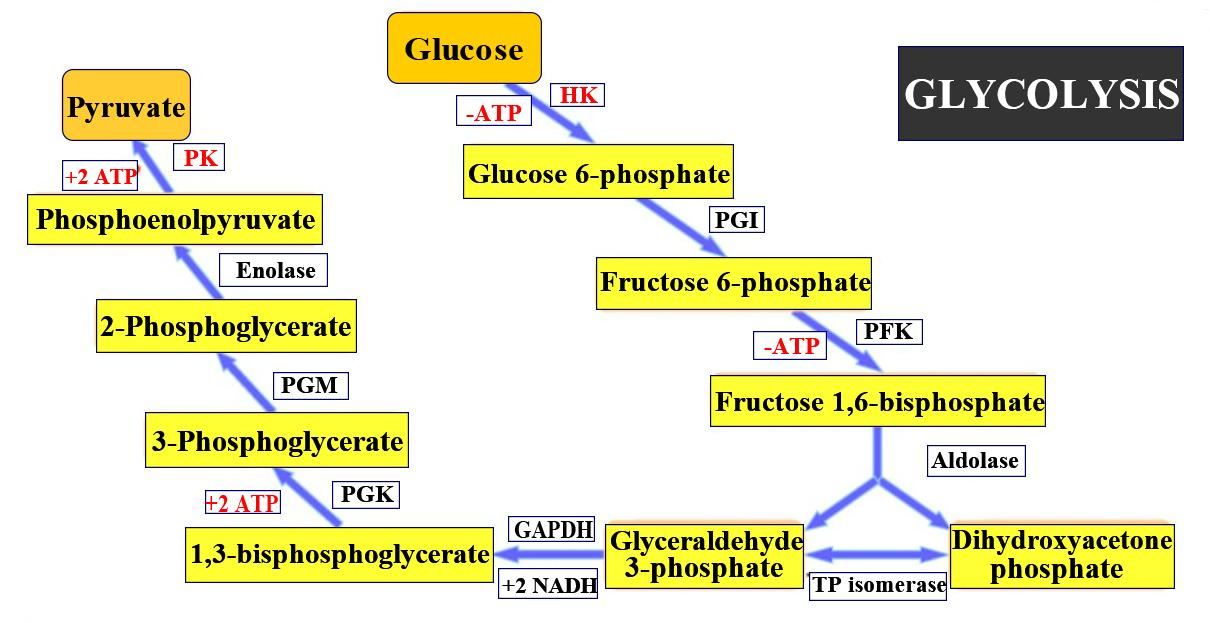Answer
397.2k+ views
Hint: Respiration in an organism takes place aerobically or anaerobically. Both aerobic and anaerobic respiration starts with the breakdown of sugar which does not require oxygen. Later aerobic organisms undergo a further process of respiration in presence of oxygen which is not shown by an anaerobic organism.
Complete answer:
Glycolysis is a cellular metabolic process occurring in both aerobic and anaerobic organisms with the conversion of carbohydrates into pyruvic acid.
Glycolysis is also called an EMP pathway because it was discovered by Gustav Embden, Otto Meyerhof, and J.Parnas. This process occurs inside the cytoplasm with the release of ATP. Glycolysis starts with phosphorylation where glucose gets converted into glucose-6-phosphate by enzyme hexokinase and magnesium ion, the second step involves the isomerization of glucose-6-phosphate to fructose-6-phosphate by enzyme phosphohexose isomerase, the third step involves phosphorylation of fructose-6-phosphate to fructose 1,6 phosphate by enzyme phosphofructokinase and ATP, the fourth step involve splitting of Fructose 1,6 phosphate into two molecules of triose phosphate by enzyme aldolase, and dihydroxyacetone phosphate further converted into glyceraldehyde-3-phosphate with enzyme phosphotriose isomerase, the fifth step involve dehydrogenation of glyceraldehyde-3-phosphate to 1,3 diphosphoglycerate in presence of enzyme triose phosphate dehydrogenase, sixth step involves the conversion of 1,3- diphosphoglycerate to 3- phosphoglycerate by enzyme phosphoglycerate kinase, the seventh step of isomerization involve conversion of 3-phosphoglycerate into 2-phosphoglycerate, eight-step involve dehydration 2-phosphoglycerate to phosphoenolpyruvate by enzyme enolase and last step involve transfer of phosphoenolpyruvate to ADP with enzyme pyruvate kinase. This produces ATP with the formation of pyruvic acid.
So, the correct answer is ‘Glycolysis’.
Note: Phosphorylation at the third step of glycolysis activates the sugar and prevents it from getting out of the cell. The net gain of ATP takes place during glycolysis is 8 ATP, 2 direct from ADP, and 6 from the oxidation of NADH.

Complete answer:
Glycolysis is a cellular metabolic process occurring in both aerobic and anaerobic organisms with the conversion of carbohydrates into pyruvic acid.
Glycolysis is also called an EMP pathway because it was discovered by Gustav Embden, Otto Meyerhof, and J.Parnas. This process occurs inside the cytoplasm with the release of ATP. Glycolysis starts with phosphorylation where glucose gets converted into glucose-6-phosphate by enzyme hexokinase and magnesium ion, the second step involves the isomerization of glucose-6-phosphate to fructose-6-phosphate by enzyme phosphohexose isomerase, the third step involves phosphorylation of fructose-6-phosphate to fructose 1,6 phosphate by enzyme phosphofructokinase and ATP, the fourth step involve splitting of Fructose 1,6 phosphate into two molecules of triose phosphate by enzyme aldolase, and dihydroxyacetone phosphate further converted into glyceraldehyde-3-phosphate with enzyme phosphotriose isomerase, the fifth step involve dehydrogenation of glyceraldehyde-3-phosphate to 1,3 diphosphoglycerate in presence of enzyme triose phosphate dehydrogenase, sixth step involves the conversion of 1,3- diphosphoglycerate to 3- phosphoglycerate by enzyme phosphoglycerate kinase, the seventh step of isomerization involve conversion of 3-phosphoglycerate into 2-phosphoglycerate, eight-step involve dehydration 2-phosphoglycerate to phosphoenolpyruvate by enzyme enolase and last step involve transfer of phosphoenolpyruvate to ADP with enzyme pyruvate kinase. This produces ATP with the formation of pyruvic acid.
So, the correct answer is ‘Glycolysis’.
Note: Phosphorylation at the third step of glycolysis activates the sugar and prevents it from getting out of the cell. The net gain of ATP takes place during glycolysis is 8 ATP, 2 direct from ADP, and 6 from the oxidation of NADH.

Recently Updated Pages
How many sigma and pi bonds are present in HCequiv class 11 chemistry CBSE

Why Are Noble Gases NonReactive class 11 chemistry CBSE

Let X and Y be the sets of all positive divisors of class 11 maths CBSE

Let x and y be 2 real numbers which satisfy the equations class 11 maths CBSE

Let x 4log 2sqrt 9k 1 + 7 and y dfrac132log 2sqrt5 class 11 maths CBSE

Let x22ax+b20 and x22bx+a20 be two equations Then the class 11 maths CBSE

Trending doubts
Fill the blanks with the suitable prepositions 1 The class 9 english CBSE

At which age domestication of animals started A Neolithic class 11 social science CBSE

Which are the Top 10 Largest Countries of the World?

Give 10 examples for herbs , shrubs , climbers , creepers

Difference between Prokaryotic cell and Eukaryotic class 11 biology CBSE

Difference Between Plant Cell and Animal Cell

Write a letter to the principal requesting him to grant class 10 english CBSE

Change the following sentences into negative and interrogative class 10 english CBSE

Fill in the blanks A 1 lakh ten thousand B 1 million class 9 maths CBSE



